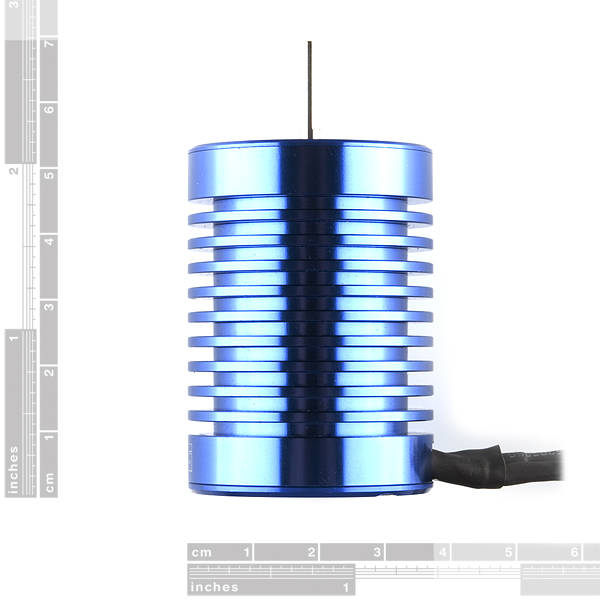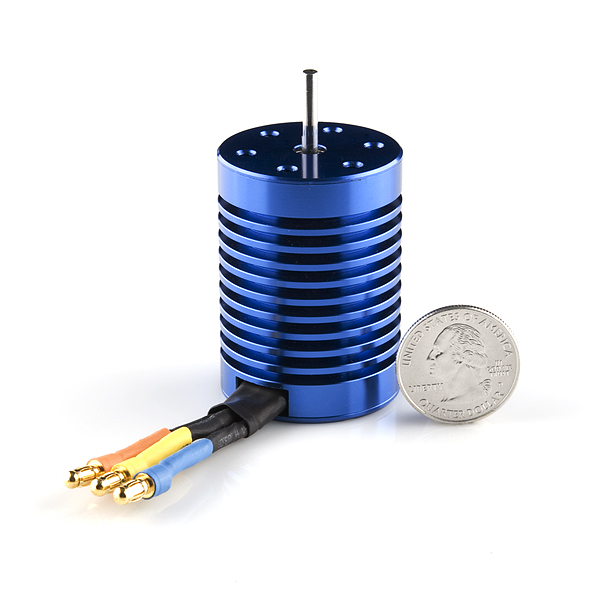Brushless Motor 13T 3000Kv
**Replacement: **None. We do not carry a direct replacement for this motor, but we are always adding new motors in our robotics section. This page is for reference only.
Looking for a motor for your next project but the brushed motor you have just doesn't quite cut it for efficiency and torque response? The EZ-RUN brushless inrunner motors give a lot of power for a little price. These are normally used for 10th or 12th scale RC cars or trucks, but they can make the difference when wringing out your bot.
**Weight: **199g (7.00oz)
- 13 turns
- 3000Kv rating* 3.175mm shaft diameter
- 36mm body diameter
- 50mm can length
- 66mm total length
Comments
Looking for answers to technical questions?
We welcome your comments and suggestions below. However, if you are looking for solutions to technical questions please see our Technical Assistance page.
Customer Reviews
No reviews yet.





I agree with Quazar. I had never heard of Kv, and kV was freaking me out thinking about 3000 kilovolts!
Hey, just a nit here, but you should change "kV" to "Kv". Have a look at this wikipedia entry: <http://en.wikipedia.org/wiki/Brushless_DC_electric_motor#Kv_rating>
You wouldn't want somebody to try to run 3000kV through one of these ;)
- Dean
ARE you guys getting more of these?
It would be nice to find a Datasheet on this motor and the 4300Kv version as well, as we know the Kv rating, but what is it's base speed? Maximum values etc. I've been searching everywhere for something on them but with no real luck at all
Could someone tell me how to determine the torque this thing gives?
Final Point...
4.) Atmel (same microcontrollers as on Arduino) have really, really well documented Application notes and theory explanation on their website for Brushless DC motor control. Particularly Sensorless control. Google the following: "AVR 928 filetype:pdf" and do the same for: AVR 172, AVR 194, AVR 444 and AVR 498.
I hope this answers the Hall Sensor Comment...these motors are controlled off Back EMF from the motor windings and dont need hall sensors...
3.) Direction control of the Motor depends on the ESC model. If it is reversible, you can implement both forward and reverse by adjusting the PWM duty cycle to the ESC. NOTE: You have to ensure that you run through the PWM range when changing direction, as it would be done if you were holding an RC trigger in your hand!!!! If you just change from, say 1ms to 2ms directly, you will change from full forward to full reverse current and voltage instantaneously. If you have a 35A ESC, this will result in over 70A which will fry all of your components, motor and ESC...so be careful!!
2.) If you don't want to pay for the Programming Card, you can program the ESC by mimicing the manual setup routine which is accomplished through pulling and pushing the trigger on an RC Remote through the throttle range. IE: send the ESC the required signal for say, full throttle (2ms@50Hz. You get the idea? Manual programming routines can easily be found in online RC forums. You can also write a bit of code to talk to an arduino over I2C and create hyperterminal commands such as "set speed" which the micro then translates into the required PWM throttle signals. (Easier than you would think) But I still say...just buy the programming card.
I have a few points to add here...
1.) I have been staring at this stuff for a while. I have a degree in Mechanical Engineering and a second degree in Electronic Engineering. If you want to save yourselves the maximum amount of implementation time, the products on this page are best value that you will find. Dont waste your time and money on e-bay. It is a nightmare programming those outdated ESCs at circa ?1-5. This is simple...buy the ESC, buy the motor, buy a programming card (once off) and the only interface which you need to the microcontroller is a PWM signal to mimic the throttle signal from an RC remote control. Typically, "The ESC accepts a nominal 50 Hz PWM servo input signal whose pulse width varies from 1 ms to 2 ms. When supplied with a 1 ms width pulse at 50 Hz, the ESC responds by turning off the DC motor attached to its output. A 1.5 ms pulse-width input signal results in a 50% duty cycle output signal that drives the motor at approximately half-speed. When presented with 2.0 ms input signal, the motor runs at full speed due to the 100% duty cycle (on constantly) output."
http://en.wikipedia.org/wiki/Electronic_speed_control
the kv refers to K sub v http://en.wikipedia.org/wiki/KV this represents rpms pre volt not kilovolts
Uhh, throwing in my two cents in hopes for some sparkfun representative feedback... uhh, a bit curious about this, these brushless motors would take the equivalent of a laser power supply (extremely high voltage) to run at their rated voltage.. which i find rather odd. I run regular brushless motors quite often (tri-pole bridge brushless motors, just like these ones) at 12 volts (the rating on my motor) and it works just fine. since when has 36 gauge magnet wire been able to have 3 kilovolts run through it without internal arcing? just wondering. by the way, if you find any large lots of harddrives being sold on the cheap, you can source LOTS of these out of those old 5-10 gig harddrives that will easily run up to 10k rpm and have fluid bearings... but i digress. i'm guessing the specs were misread on this one or something.. i just have some extreme disbelief that these would take 3 kilovolts without some serious enamel wire melt-action...
If you do pump 3kV through one of these motors, please take pictures/videos and send us them.
Take a look at this wiki article about the definition of Kv:
http://en.wikipedia.org/wiki/Brushless_DC_electric_motor#Kv_rating
Cool suggestion on hard drive motors. I'll have to find some old hard drives and try it out.
Could you guys post some specs on this? Voltage rating and rated speed if you have it.
Line-to-line resistance and inductance would be nice if you can measure it.
Huge kV rating! If you want a robot that goes 80mph, then this is your choice.
Needs gearbox, me thinks. At 3.7V it runs 11.000rpm which is "quite" fast..
Yup, it'll go fast, alright. But FWIW, most at the AVC use 1/10 scale RC as a platform, so we felt this would have a home here. And I can think of a few other uses for a motor like this besides an 80mph bot...but yeah, we'd like to source a gearbox, too.
someone knows how to interface this stuff with a normal microcontroller?
I mean, I got a bunch of "speling explanation" and not a very clear one... I see a bunch of three phases and everything stuff but, nothing that really cleared my mind :S
maybe I'm a dummy guy, probably, so someone knows or can make a brushless motor for dummies?
Hey, just giving my 2 cents here, but I think the best way to interface this to a ?c is by using one of the ready made ESC you can find listed on this page.
And using one of the PWM from yout ?c to send a servo like PWM control to the ESC.
Good luck guys ;)
@SilverGhost
Have you ever tried the technique you mentioned that is controlling the BLDC with ESC using the servo control signal from the micro-controller. I am actually trying to do same with an arduino board. I was able to run the motor but it get programmed somehow and now i can't program it again.
I will be grateful for any help.
I've been looking into this stuff. You can start looking here:
http://www.google.com/search?hl=en&q=driving+a+3+phase+bridge&aq=f&aqi=&aql=&oq=&gs_rfai=
and
http://www.google.com/search?hl=en&q=driving+a+bldc&aq=f&aqi=&aql=&oq=&gs_rfai=
Find some app notes and they'll explain how it works.
I've been designing a 3 phase brushless controller for a little while now. I get PCBs in this week!
-Taylor
hm, so, I took a read and I think I understood something...
but I saw the hall sensors stuff and how they act to know where the motor is at the moment... but where they are on this one? it has only 3 pins so would be for the 3 phase stuff, and the hall sensors?
maybe a dumb question, but I don't know it, so...
Hey,
Glad you got some understanding.
I found the app note I was really looking for.
http://ww1.microchip.com/downloads/en/AppNotes/00885a.pdf
Note the part "Sensorless Control of BLDC Motors" Under the "What is Back EMF?" section.
Read through the whole thing though if you can, this is a good app note! :)
-Taylor